Happy Holidays (2024) & New Year from Lifeway Mobility

Watch the Lifeway Mobility 2024 "Happy Holidays" Video:

Watch the Lifeway Mobility 2024 "Happy Holidays" Video:

“It’s the most wonderful time of the year!” The holiday season is officially here, bringing lots of joy and cheer to families and friends gathering for holiday events and parties
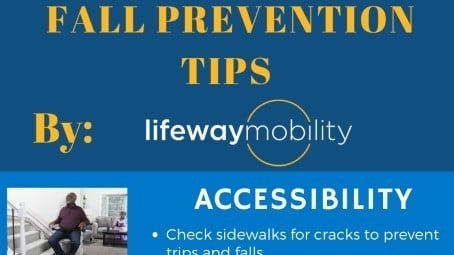
As we age, our home may not be as easy to navigate as it was years ago. Getting up and down a set of stairs may be a chore because of decline in mobility or weaker muscles. The risk of slipping and falling in the bathroom may be much higher, especially if there are no grab bars in the bathtub/shower, or near the toilet. An option for older adults that are having a difficult time getting around at home is a senior/assisted living facility. However, these types of facilities do not offer the familiarity and comfort that a home does. A home is full of memories from holidays and gatherings with family and lifelong friends.

Our home accessibility experts are invited into our client’s homes and into our local communities to evaluate for home accessibility solutions, such as stair lifts or wheelchair ramps or lifts. During our evaluations, we often encounter modifications that were done by another company or DIYs that do not meet ADA requirements, or are unsafe.

People diagnosed with cancer often require additional safety precautions to ensure that any health-related problems do not occur. Day-to-day activities that can be taken for granted will become harder. Simple things like cooking, cleaning, and even walking up the stairs may become strenuous, and even dangerous.
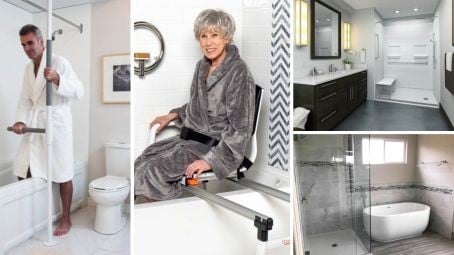
Falls are a hazard that the elderly and people with mobility issues face every day – and the majority of falls happen in the bathroom. In fact, the Centers for Disease Control and Prevention (CDC) has declared the bathroom the most dangerous room in the house for older adults.
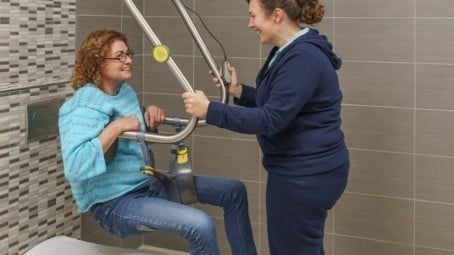
A ceiling lift can be a great alternative to an accessible bathroom remodel when budget is limited. Any sort of bathroom remodeling involves permits, construction, and can cost tens of thousands of dollars.

"They're Coming Home!...Now What?" Whether the stay at the hospital was expected or due to an emergency, homecoming is what everyone is waiting for - but it must be planned for to ensure a safe transition home.
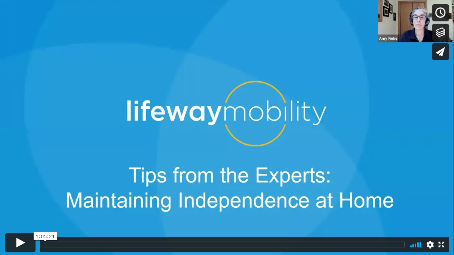
We wanted to share a recording of our webinar, "Tips from the Experts: Maintaining Independence at Home", for those who were unable to attend when it was presented live on October 28th, 2020.

"My dad had a stroke and can't climb the stairs inside or outside his home." We hear stories like this every day and our Accessibility Specialists are experts at solving mobility challenges in a variety of environments in and around the home. If you or a loved one struggles with mobility, this FREE webinar provides invaluable tips and product recommendations to help maintain mobility, safety and independence.

Lifeway Mobility announced today that it has acquired the assets of Home Mobility Solutions, Inc. (HMS), Downers Grove, IL, through its subsidiary, Extended Home Living Services, Inc (EHLS), Arlington Heights, IL. Founded by Mike Cleary, HMS has served greater Chicagoland and northwest Indiana, offering accessibility solutions including stairlifts, wheelchair lifts, modular ramps, bathroom modifications and elevators, for over 12 years.
As we age, our balance, strength, and vision can begin to decline, and navigating stairways, steps, stoops, and landings can become increasingly difficult. Progressive illnesses and injuries can also cause these familiar household structures to become hazardous. In fact, falls are the leading cause of death and injury to older adults and a common reason that people give up on independent living.

If you have worked in or been to an elementary, middle, high school, or even a university lately, you may have noticed that there are many diverse situations that need to be accommodated for: wheelchairs, walkers, space for physical and occupational therapy, barrier-free playground equipment, etc. Many schools throughout the country are older and were not built with these accommodations in mind, and despite the Americans with Disabilities Act, some schools are not as compliant as they could be. So, if you are an administrator looking to adapt your school’s environment for students with disabilities or a parent wanting more access, read on for more tips on accessibility!

With the therapeutic benefits of warm water therapy gaining notoriety, you may be in the market for a new soaking or walk-in bathtub. If this is the case, you might have seen an option called a hydrotherapy air tub. While many people are familiar with tubs outfitted with whirlpool jets, commonly called a Jacuzzi tub, an air tub is a newer concept.

Walk-in bathtubs have long been known as an accessible bathing solution for people with limited mobility. But did you know that recent studies have also highlighted the therapeutic benefits of walk-in tubs? A walk-in tub can help people with a variety of conditions, including:

For seniors and those with limited mobility, grab bars can be a lifesaver. There are many types of grab bars that can be added throughout different rooms in a home to provide stability for people who have trouble walking. The bathroom is often the room that makes the most sense for the installation of a grab bar because it is the most dangerous room in a house for seniors or those with limited mobility. In fact, falls in the bathroom due to a wet, slippery floor is one of the top causes of injuries for elderly men and women. Whether it's the barrier that makes it difficult to get in and out of a tub or shower or a toilet that is tough to get off of, the bathroom definitely presents its challenges.

Fast approaching is that wonderful time of year when family and friends gather to celebrate the holidays. Often that means events and parties that include elderly parents, friends or relatives. Whether an elderly relative or friend with limited mobility is coming for the afternoon or staying longer, it is best to consider their safety and comfort.

As we age, getting in and out of a bathtub can become a difficult task that can put us at risk of injury. For those that enjoy a warm bath after a long day but have trouble lowering themselves into a standard bathtub, a walk-in tub might be the perfect solution. A walk-in bathtub features a water-tight door that swings either in or out, and a built-in seat that allows you to bathe in a seated position. This means you can avoid lowering yourself into a traditional bathtub.
As we age, tasks that we once took for granted such as climbing the stairs or taking a shower, can become a challenge. If you or a loved one are planning to Age-in-Place, there many home modifications or adaptations that can help make this a reality.
Lifeway Mobility is happy to announce that Clean Cut bathtub modifications are now available to our customers in Minnesota and western Wisconsin.
Are you struggling to take care of mom and dad…AND your children? Lifeway Mobility helps people in the sandwich generation* care for both their parents and their children and keep them safe. We offer a variety of services in child safety and accessibility remodeling.
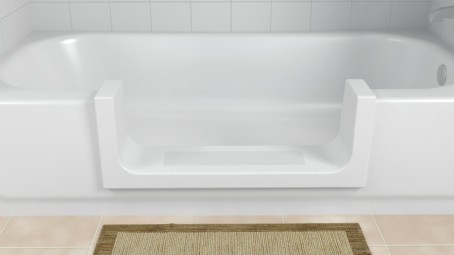
Changes in balance and mobility can become a problem as we age, and getting in and out of the tub can be especially hazardous. If stepping over the side of the bathtub is a safety concern for you, a tub cut may be the best solution.

As we age, simple tasks such as taking a shower can become a challenge. Bathrooms can be especially risky for those with limited mobility due to slick surfaces and the movements required for bathing and toileting. The National Safety Council estimates that each year, over 200,000 people are injured in their bathrooms. These injuries are mostly due to falls and many of them are preventable.

For those with limited mobility, a traditional step-in bathtub can often be a challenge or even a safety hazard. Luckily there are solutions for those who want to be able to take a warm bath but for whom a standard tub is no longer a safe option. These solutions include tub cut-outs and walk-in bathtubs. While these both achieve the basic goal of making a bathtub accessible, they differ greatly in features, cost, and potentially ease of use depending on the user's mobility.
If you have difficulty stepping into your traditional bathtub/shower, it may be time to consider converting your tub into a walk-in shower. While remodeling your bathroom to include a zero-threshold shower (also known as barrier-free, curbless, or roll-in shower) may be out of your budget, there is a lower cost option that can help make your existing tub accessible again. This option is known as a tub cut or tub cut-out and might be the right solution for you. However, depending on the extent of your mobility issues, a fully accessible, barrier-free shower may be the better option.